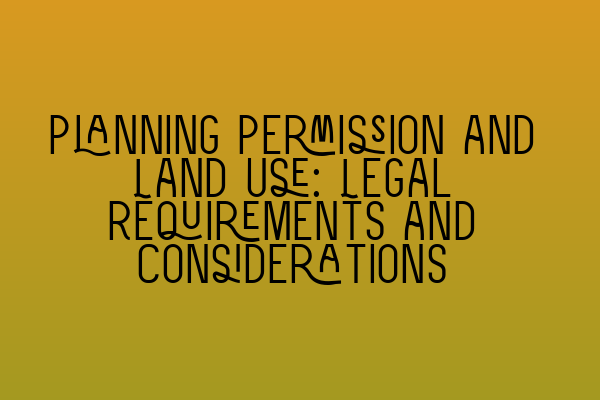Planning Permission and Land Use: Legal Requirements and Considerations
Welcome to SQE Property Law & Land Law! As experts in the field, we are here to guide you through the complex process of planning permission and land use. Whether you are a property owner, developer, or simply someone interested in understanding the legalities involved, this blog post will provide you with valuable insights.
1. Introduction to Planning Permission
Planning permission is the official consent required to carry out certain types of development on land. It is granted by local planning authorities and ensures that development is carried out in accordance with relevant regulations and policies. Obtaining planning permission can be a daunting process, but it is essential to ensure legal compliance and avoid potential legal issues in the future.
2. Understanding Land Use Classes
Land use classes are a vital aspect of planning permission. They categorize different types of land use, such as residential, commercial, industrial, and agricultural. Understanding the specific land use class of a property is crucial, as it determines the permitted uses and potential limitations of that land. It is essential to consult local planning authorities or seek legal advice to determine the correct land use class for your property.
3. Applying for Planning Permission
When seeking planning permission, it is crucial to understand the legal requirements and considerations involved. Here are the key steps involved in the application process:
– Conduct thorough research: Before applying for planning permission, it is important to research the relevant regulations, policies, and guidelines that apply to your proposed development. Familiarize yourself with the local planning authority’s requirements to ensure you provide all the necessary information in your application.
– Prepare a comprehensive application: Your planning permission application should include detailed plans, drawings, and supporting documents that clearly outline the proposed development. It is essential to provide accurate and complete information to increase your chances of approval.
– Consult with stakeholders: Depending on the nature of your development, you may need to consult with various stakeholders, such as neighbors, community groups, or environmental agencies. Engaging with these stakeholders early in the process can help address concerns and mitigate potential objections.
– Public notification and consultation: In some cases, especially for larger-scale developments, public notification and consultation may be required. This involves notifying the public about the proposed development and allowing them to submit comments or objections.
4. Legal Issues and Considerations
When it comes to planning permission and land use, several legal issues and considerations may arise. Here are a few important ones to keep in mind:
– Compliance with local development plans: Local planning authorities have development plans in place that set out their vision for growth and development in the area. It is vital to ensure that your proposed development aligns with these plans to increase the likelihood of obtaining planning permission.
– Environmental impact assessment: Certain developments may require an environmental impact assessment (EIA) to assess the potential environmental effects. If your development falls within this category, it is crucial to comply with the EIA regulations and provide the necessary information required.
– Listed buildings and conservation areas: If your property is a listed building or located within a conservation area, additional permissions and considerations may apply. It is essential to consult with heritage and conservation authorities to ensure compliance with the relevant regulations.
– Change of use applications: If you are proposing a change of use for a property, you may need to submit a separate application to obtain the necessary permissions. Change of use applications can be complex, and it is advisable to seek legal advice to navigate through the requirements.
– Community infrastructure levy: In some cases, developers may be required to pay a community infrastructure levy (CIL) to support local infrastructure projects. Understanding CIL regulations and complying with payment requirements is crucial to avoid potential legal issues.
5. Seeking Legal Advice
Navigating the complexities of planning permission and land use can be challenging. It is highly recommended to seek legal advice from professionals experienced in property and land law. At SQE Property Law & Land Law, our team of solicitors is here to provide expert guidance and support throughout the process.
By understanding the legal requirements and considerations surrounding planning permission and land use, you can navigate the process more effectively and ensure compliance with relevant regulations. Remember, obtaining planning permission is crucial to avoid legal complications and ensure the success of your development project.
If you found this blog post informative, you may also find the following articles helpful:
– Misrepresentation in Contracts: Unveiling Deceptive Practices
– A Closer Look at SQE Contract Law Syllabus
– SQE Contract Law: Analyzing Landmark Cases and Influential Judicial Decisions
– Contract Law for Services: Key Considerations and Best Practices
– Understanding Contractual Capacity: Rights and Limitations
For more information or to schedule a consultation with our solicitors, please contact SQE Property Law & Land Law. We are here to provide you with the expert advice and support you need.
